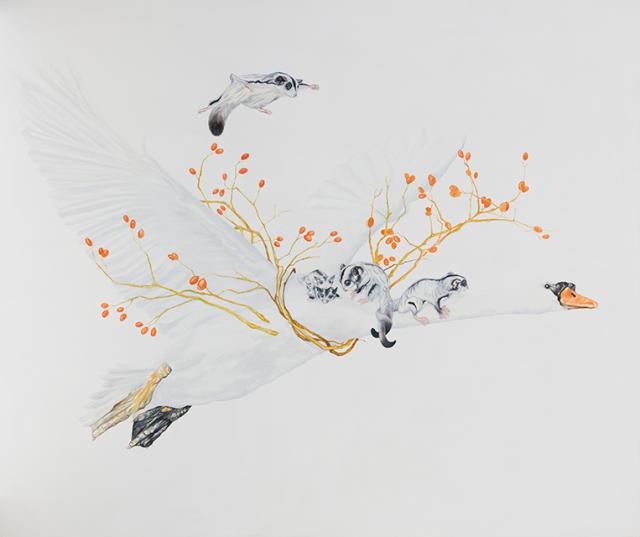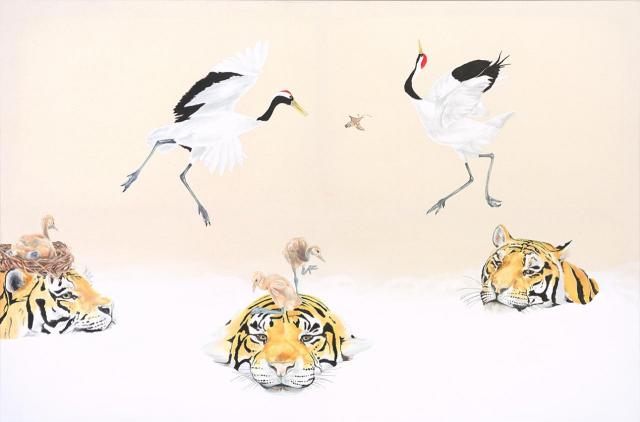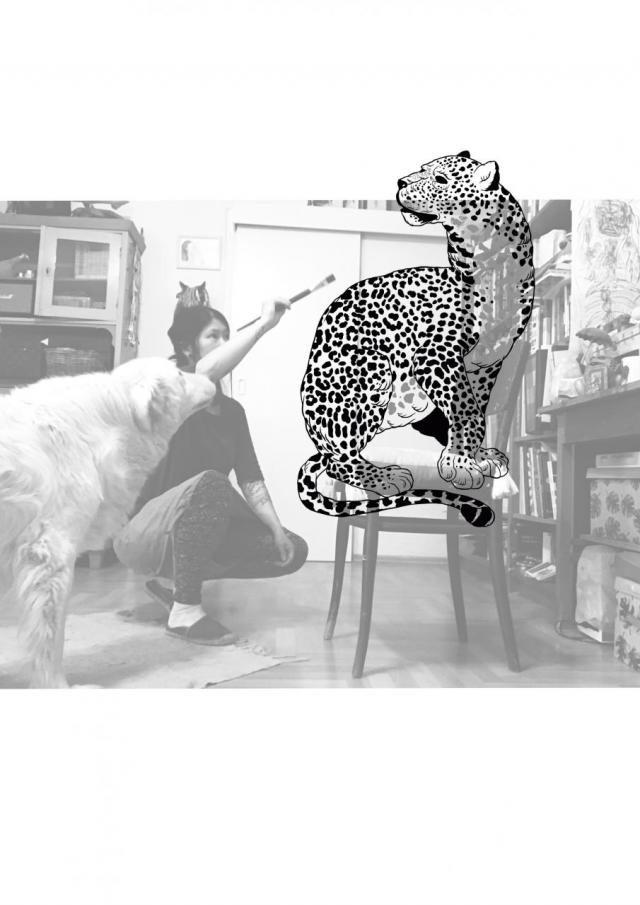Animalistic. About Symbiotic Relationships and Survival Strategies
Ivana: What does “animalistic” mean to you?
Ina: It's unbelievable how many animals from different species form sophisticated symbioses through connected interactions. This moves and fascinates me so much that I want to give space to the animal hero_ines and protagonists, and let them act as role models for the viewer.
Ivana: How long have wild animals been the main motif in your artwork and why?
Ina: I think the origin is my experience of growing up with my dog Guggi. Taking care of him, sharing, playing, and learning together, talking without talking. My faithful companion and protector. All of these elements shaped me a lot and made me more attentive, more focused on absorbing stimuli from nature and her wondrous inhabitants. Fascinated by this, I absorbed all the stories, and thus the wild animals soon moved into my work. There my animal heroes_ines meet all kinds of different fellow species and tell a new story together. I want to draw attention to these beautiful, shy, and clever creatures, lend them my voice, and share with you what they have to say.
Ivana: We talked a lot about symbiotic relationships as one of the main themes of your exhibition at Kunstraum Innsbruck. Ironically, we had to postpone the exhibition because of the Coronavirus. I remember in one conversation you talked about symbiosis, but also in terms of malignant symbiosis. Can you talk a bit more about this, how you see this relationship in nature and how you work on it artistically?
Ina: For me, a malignant symbiosis describes the imbalance that we humans create through deforestation and fragmentation. The quality of the habitats is lost, many species become extinct and some of the forest's talented survivors move closer and closer to the city. In a symbiosis, the sense of purpose is that those who join together also have an advantage and benefit from it. The natural ecosystem of nature can rebalance itself. For this, it needs protection, more space, phases of peace, a process for recreation. Now it is up to us, as human animals, to strive for regeneration for our symbiotic well-being, which our planet so urgently needs. The animal and human protagonists in my work make every effort to maintain a balance, to respect symbioses, to dare to interact. They are courageous, although certain dangers still lurk.
Ivana: You were born in Tyrol into a Taiwanese family that migrated to Austria. What was it like for you to grow up here as a girl and woman from an Asian family? What anti-racist strategies did you find, and what empowered you?
Ina: A few years ago, I would have answered this question with a more detailed story of suffering, but now, I can simply say it was not easy growing up in Tyrol. Being different and the way some people reacted to it had a lot of influence on me and I found refuge in my pets and in nature. As a child and also later in my youth, I wished that I could adapt my appearance as I did with language and clothing. All attempts, from dying my hair blond to wearing blue lenses, ended with me realizing that I cannot hide my Asian appearance. For a long time, I closed myself off to my parents’ culture, I didn’t want anything to do with it. Today I am happy and appreciate having insight into two cultures, I am constantly in a state of discovering because there is still so much to catch up on.
This experience has not made me harder, I am still the same sensitive soul, which is a quality that enables me to feel into other people and animals. For a long time, I had a feeling this characteristic is a weakness but now I am sure that helps me to make my artistic work authentic and give life to my protagonists (also animal ones).
Ivana: How has Taiwanese and Asian culture informed your art, which artistic impulses have inspired you?
Ina: Since I became interested in the culture of my parents and ancestors very late in life, the influence was rather unconscious, it came from the many Asian ink images and watercolor drawings hanging everywhere on walls, both at home in the apartment and in my parents’ Chinese restaurant. Also, I am very enthusiastic about the works of Lang Shining (Guiseppe Castiglione), they influence me a lot. He was an Italian artist who, in the 18th century, worked as a court painter in China for over 50 years under three emperors. In his work one sees both western and Asian influences. Often when I am confronted with an artistic dilemma, I like to look at how he solved it in his works.
Ivana: How do you choose the animals?
Ina: The choice of my animal protagonists depends a lot on the process approach, their subject matter, and the different stimuli I perceive in my own environment. These are influences that cannot be planned: an animal documentary, an article, a picture directs my attention, or a look into my paludarium arouses my curiosity to research my new animal protagonists. I live with four dogs and observing how they relate to each other is an exciting field, it shows how social and “humane” a dog can be towards its fellow species…
Ivana: Your future vision for planet Earth?
Ina: The answer is rather a question. Do we want to be treated by other people the way we treat animals? Destruction of the habitat, mass animal farming, and the general disregard and disrespect for nature and the animal world - that is probably not a world in which we want to live. We could learn a lot from the animals with whom we share the planet. Perhaps then people would show more modesty, understanding, and respect.







